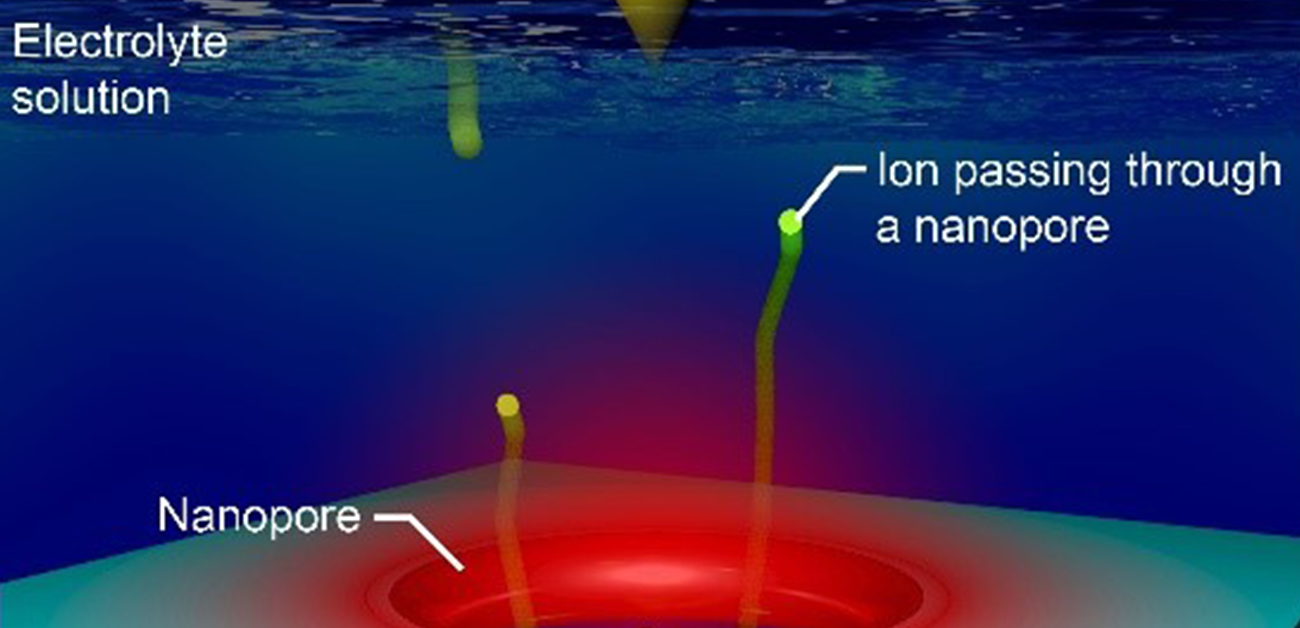
Nanopores feel the heat
Researchers at Osaka University use a tiny thermometer to directly monitor changes in temperature when ions pass through a nanopore, which may lead to more efficient DNA sequencing technology
Scientists from SANKEN (the Institute of Scientific and Industrial Research) at Osaka University measured the thermal effects of ionic flow through a nanopore using a thermocouple. They found that, under most conditions, both the current and heating power varied with applied voltage as predicted by Ohm’s law. This work may lead to more advanced nanoscale sensors.
Nanopores, which are tiny openings in a membrane so small that only a single DNA strand or virus particle can pass through, are an exciting new platform for building sensors. Often, an electrical voltage is applied between the two side of the membrane to draw the substance to be analyzed through the nanopore. At the same time, charged ions in the solution can be transported, but their effect on the temperature has not been extensively studied. A direct measurement of the thermal effects caused by these ions can help make nanopores more practical as sensors.
Now, a team of researchers at Osaka University have created a thermocouple made of gold and platinum nanowires with a point of contact just 100 nm in size that served as the thermometer. It was used to measure the temperature directly next to a nanopore cut into a 40-nm-thick film suspended on a silicon wafer.
Joule heating occurs when electrical energy is converted into heat by the resistance in a wire. This effect occurs in toasters and electric stoves, and can be thought of as inelastic scattering by the electrons when they collide with the nuclei of the wire. In the case of a nanopore, the scientists found that thermal energy was dissipated in proportion to the momentum of the ionic flow, which is in line with the predictions of Ohm’s law. When studying a 300-nm-sized nanopore, the researchers recorded the ionic current of a phosphate buffered saline as a function of applied voltage. “We demonstrated nearly ohmic behavior over a wide range of experimental conditions,” first author Makusu Tsutsui says.
With smaller nanopores, the heating effect became more pronounced, because less fluid from the cooler side could pass through to equalize the temperature. As a result, the heating could cause a non-negligible effect, with nanopores experiencing a temperature increase of a few degrees under standard operating conditions. “We expect the development of novel nanopore sensors that can not only identify viruses, but might also be able to deactivate them at the same time,” senior author Tomoji Kawai says. The researchers proposed other situations in which the heating can be beneficial—for example, to prevent the nanopore from being clogged by a polymer, or to separate the strands of DNA being sequenced.

Fig.1 Schematic diagram showing the process of ionic heat dissipation in a nanopore (left). A nanoscale thermometer embedded on one side of the nanopore to detect local temperature changes caused by voltage-driven ionic transport (right). (CC0 © 2022, M. Tsutsui et al. Ionic heat dissipation in solid-state pores. Science Advances)
The article, “Ionic heat dissipation in solid-state pores,” was published in Science Advances at DOI: https://doi.org/10.1126/sciadv.abl7002
Related Links
Tsutsui Makusu (Researcher Directory)
EurekAlert!
AlphaGalileo
Previous Research Results
How low can we go? Nanopore detection of single flu viruses to control outbreaks
https://resou.osaka-u.ac.jp/en/research/2018/20181121_1
Novel viral identification method developed
https://resou.osaka-u.ac.jp/en/research/2019/20190110_3
Sorting out viruses with machine learning
https://resou.osaka-u.ac.jp/en/research/2020/20201110_2
Shutting the nano-gate
https://resou.osaka-u.ac.jp/en/research/20210316_2
Above the noise
https://resou.osaka-u.ac.jp/en/research/2021/20210514_1
In situ extraction and detection of DNA is an im-pore-tant development
https://resou.osaka-u.ac.jp/en/research/2021/20210824_2


